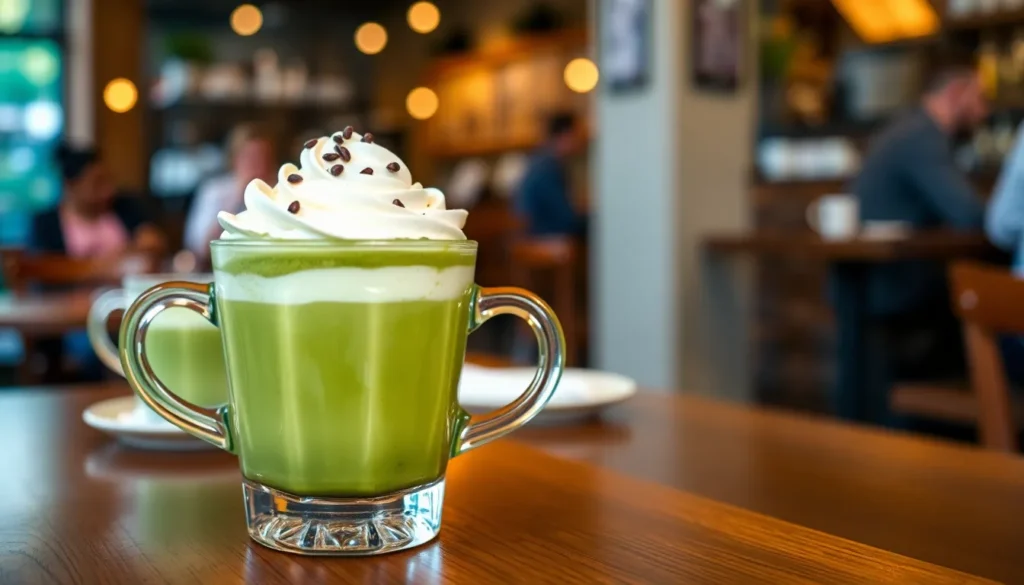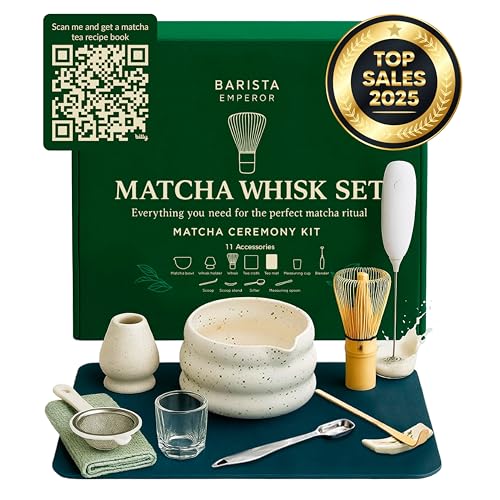We’ve discovered the perfect marriage of East meets West in this vanilla matcha latte that’ll revolutionize your morning routine. This creamy café-style drink combines the earthy richness of premium Japanese matcha with the sweet comfort of vanilla and silky steamed milk.
What makes our vanilla matcha latte special isn’t just its Instagram-worthy green hue – it’s the balanced flavor profile that delivers sustained energy without the coffee crash. Unlike traditional lattes matcha provides L-theanine which promotes calm focus while the vanilla adds just the right touch of sweetness.
We’ll show you how to create this antioxidant-packed beverage at home using simple ingredients and techniques that rival your favorite coffee shop. Whether you’re a matcha enthusiast or curious newcomer this recipe delivers barista-quality results every single time.
Ingredients
Creating our perfect vanilla matcha latte requires high-quality ingredients that work together to balance the earthy matcha with sweet vanilla notes. We’ve organized these ingredients by preparation stage to streamline your brewing process.
For the Matcha Base
- 1 teaspoon ceremonial grade matcha powder
- 2 tablespoons hot water (175°F to 185°F)
- 1 cup whole milk or oat milk
- 1 tablespoon coconut oil or MCT oil (optional for creaminess)
For the Vanilla Syrup
- 1/4 cup granulated sugar
- 1/4 cup water
- 1 teaspoon pure vanilla extract
- 1 vanilla bean pod split and scraped (optional for enhanced flavor)
For Assembly and Garnish
- Ice cubes (for iced version)
- Whipped cream or frothed milk
- Matcha powder for dusting
- Vanilla bean seeds for garnish
- Honey or maple syrup to taste
Equipment Needed
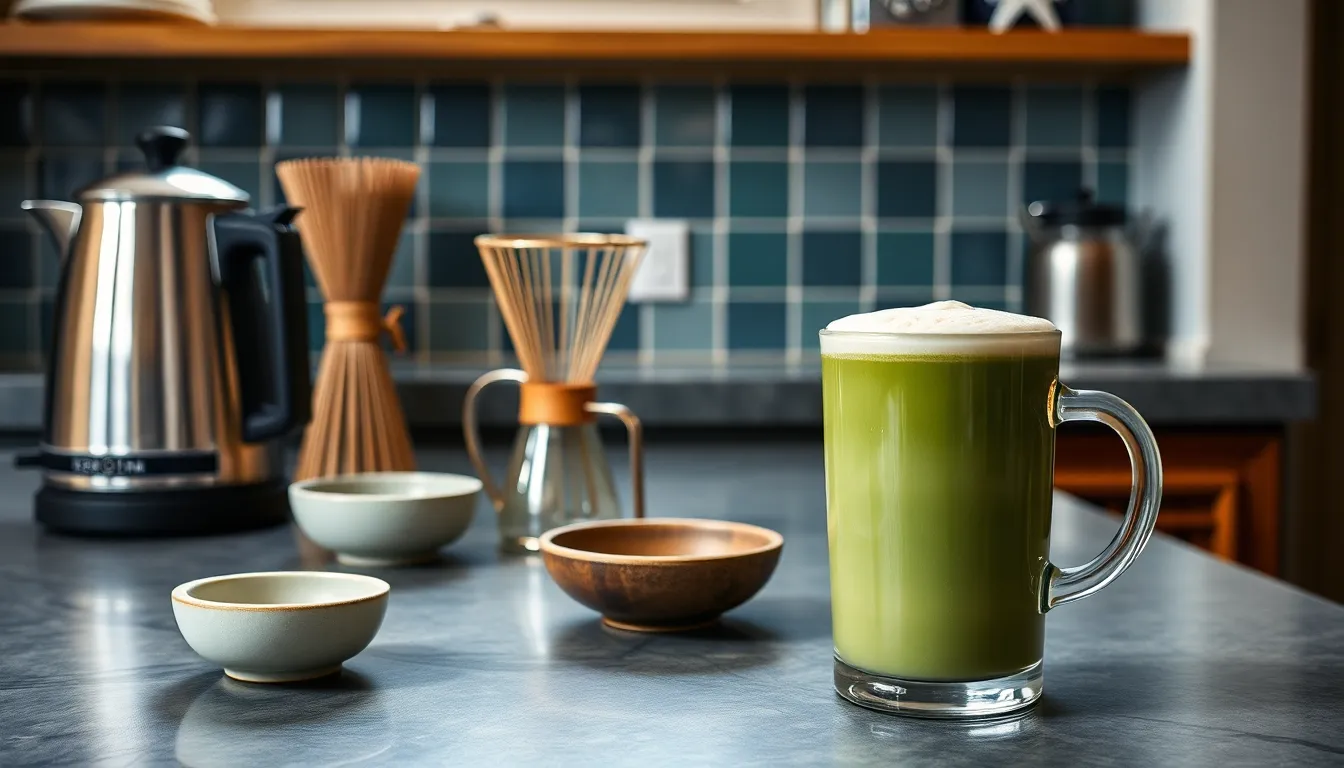
Creating the perfect vanilla matcha latte requires exact tools that ensure optimal flavor extraction and proper texture. We’ve organized our equipment list to help you achieve barista-quality results at home.
Essential Brewing Equipment
Water heating tools form the foundation of our brewing process. A temperature-controlled kettle works best for maintaining the ideal 70-80°C range that prevents matcha bitterness. Small saucepans or microwaves serve as practical alternatives when precise temperature control isn’t available.
Whisking implements determine the smoothness of your matcha base. Traditional bamboo whisks (chasen) create the most authentic frothy texture through their fine tines. Small metal whisks or even forks provide adequate mixing when traditional tools aren’t accessible.
Mixing vessels should accommodate vigorous whisking without spillage. Small ceramic bowls offer ideal depth and width for proper matcha preparation. Wide-mouth mugs work well as alternatives while doubling as serving vessels.
Milk Preparation Tools
Frothing equipment elevates your latte’s texture and temperature. Electric milk frothers provide consistent results with minimal effort. Hand-held frothers offer portable convenience for single servings. French presses create excellent foam through their plunging mechanism when dedicated frothers aren’t available.
Heating methods vary based on your kitchen setup. Stovetop saucepans allow precise temperature control for milk warming. Microwave heating offers speed and convenience for quick preparation.
Measuring and Serving Essentials
Precision tools ensure consistent flavor balance. Digital kitchen scales provide accurate matcha measurements for reproducible results. Standard measuring spoons work adequately when scales aren’t available.
Serving vessels complete your latte presentation. Heat-resistant glass mugs showcase the beautiful green color while maintaining temperature. Ceramic cups offer traditional appeal with excellent heat retention properties.
Optional Enhancement Tools
Sifting equipment removes matcha clumps for ultra-smooth texture. Fine-mesh sieves create professional-quality powder consistency. Small strainers serve as practical alternatives for home preparation.
Storage containers preserve matcha freshness between uses. Airtight glass jars protect against moisture and light exposure. Sealed metal tins provide portable storage options for travel preparation.
Instructions
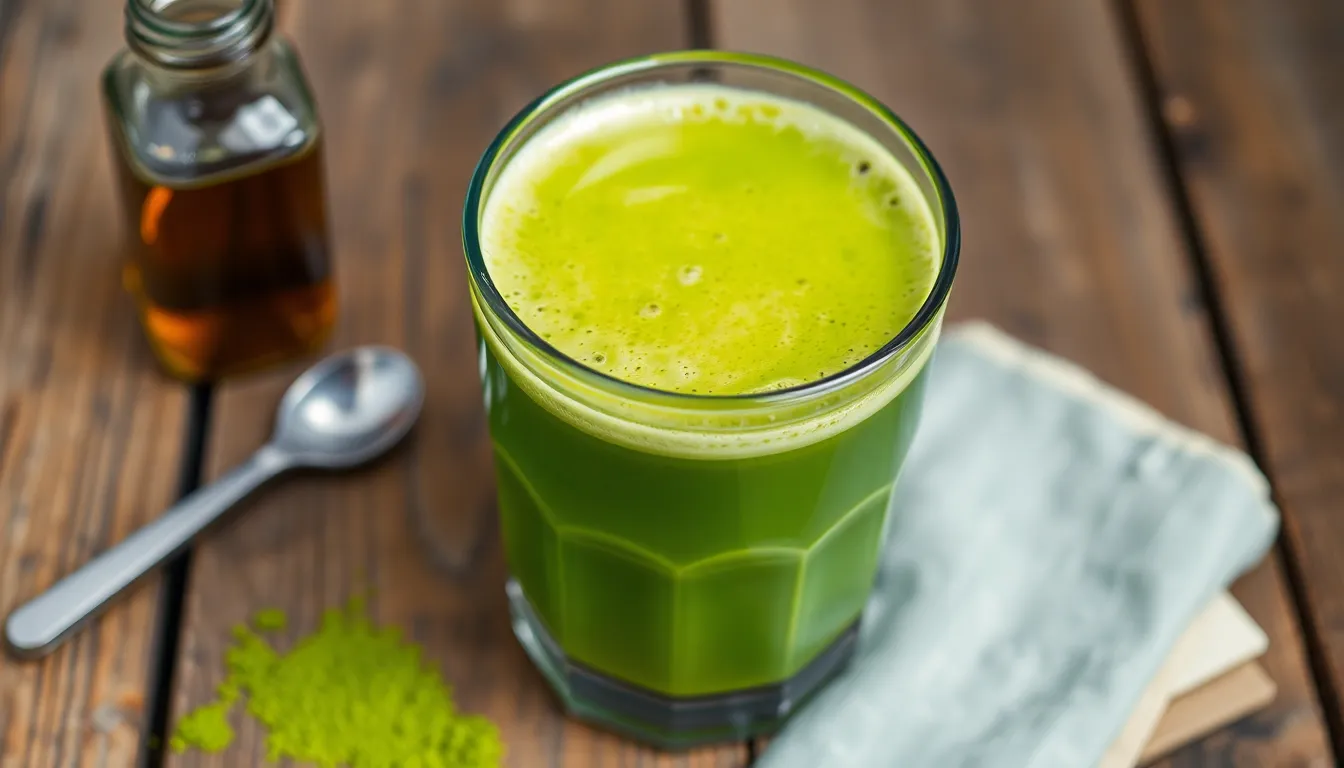
Now that we have our equipment ready and ingredients measured, let’s walk through the step-by-step process to create this perfect vanilla matcha latte.
Prepare the Vanilla Syrup
We begin by creating our homemade vanilla syrup that will add the perfect sweetness to our latte. Combine 1 cup of granulated sugar and 1 cup of water in a medium saucepan over medium heat. Stir the mixture continuously until the sugar completely dissolves and the liquid becomes clear. Remove the saucepan from heat and add 1 tablespoon of pure vanilla extract, stirring gently to incorporate. Allow the syrup to cool completely before transferring it to a clean glass jar for storage. This vanilla syrup will keep in the refrigerator for up to one month and provides the ideal sweetness balance for our matcha latte.
Make the Matcha Paste
We start our matcha preparation by sifting 1 to 2 teaspoons of ceremonial grade matcha powder into a wide bowl or mug to eliminate any clumps. Heat water to the optimal temperature range between 140°F and 175°F for the best flavor extraction. Add approximately ¼ cup of the heated water to our sifted matcha powder. Using a bamboo matcha whisk, we vigorously whisk the mixture in a zigzag motion until the matcha becomes completely emulsified and develops a rich, frothy texture. Continue whisking for about 30 seconds until we achieve a smooth paste without any visible lumps. The resulting mixture should have a vibrant green color and creamy consistency.
Steam or Froth the Milk
We warm ¾ to 2 cups of our chosen milk using either a stovetop saucepan, microwave, or steam wand attachment. Heat the milk to approximately 150°F to 160°F, being careful not to let it boil as this can affect the texture and taste. Once heated, we create our desired froth using an electric frother, hand whisk, or blender. Froth the milk vigorously for about 30 seconds until it reaches a creamy, velvety consistency with microfoam on top. The frothed milk should have increased in volume and display a smooth, glossy appearance that will create the perfect canvas for our vanilla matcha latte.
Assemble the Vanilla Matcha Latte
We combine our prepared matcha paste with 1 to 2 teaspoons of vanilla syrup directly in our serving cup, adjusting the amount based on our preferred sweetness level. Pour the steamed and frothed milk slowly over the matcha and vanilla mixture, creating beautiful layers as the ingredients blend. Gently stir the latte if needed to ensure even distribution of flavors throughout the drink. For an iced version, we add ice cubes to a tall glass before pouring in our vanilla milk and matcha mixture, then stir well before serving. The final result should showcase a beautiful green hue with a creamy foam top that perfectly balances the earthy matcha with sweet vanilla notes.
Tips for the Perfect Vanilla Matcha Latte
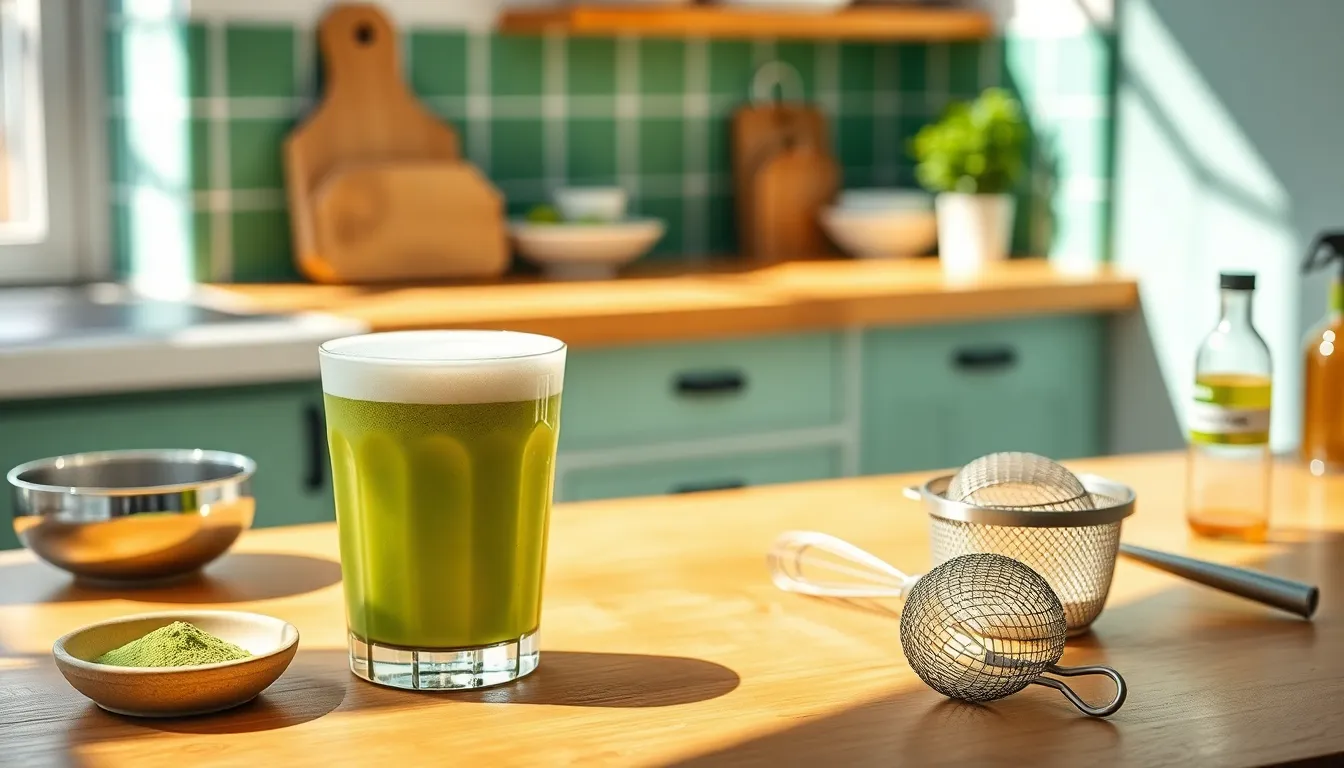
Quality matcha makes all the difference in your final cup. We recommend using ceremonial grade matcha for the smoothest flavor profile and vibrant green color. Culinary grade matcha works well too but may require additional sweetener to balance any slight bitterness.
Water temperature plays a crucial role in extracting optimal flavor. We heat our water to 175°F rather than boiling to prevent scorching the delicate matcha powder. This temperature preserves the tea’s natural sweetness and prevents bitter notes from developing.
Proper whisking technique creates that signature frothy texture. We whisk the matcha paste in a zigzag motion using quick wrist movements for 30 seconds. This traditional method incorporates air and eliminates any lumps that could affect the drink’s smoothness.
Sweetness balance requires careful adjustment to personal taste. We start with 1 tablespoon of vanilla syrup and gradually add more if needed. Different matcha brands vary in natural sweetness so we taste test before serving.
Milk choice significantly impacts both flavor and texture. We find oat milk creates the creamiest consistency while almond milk offers a lighter option. Coconut milk adds tropical notes that complement the vanilla beautifully.
Frothing temperature affects the final drink quality. We heat milk to 140°F for optimal frothing without scalding. Overheated milk develops a burnt taste that overpowers the delicate matcha flavors.
Sifting prevents clumps and ensures smooth integration. We always sift matcha powder through a fine mesh strainer before whisking. This extra step eliminates stubborn clumps that resist breaking down during preparation.
Fresh preparation yields the best results. We recommend consuming matcha lattes within 30 minutes of preparation. The vibrant color and smooth texture begin to deteriorate as the drink sits due to oxidation.
Storage methods preserve matcha quality between uses. We keep opened matcha powder in an airtight container in the refrigerator where it maintains freshness for up to 6 months. Room temperature storage reduces potency within weeks.
Variations and Customizations
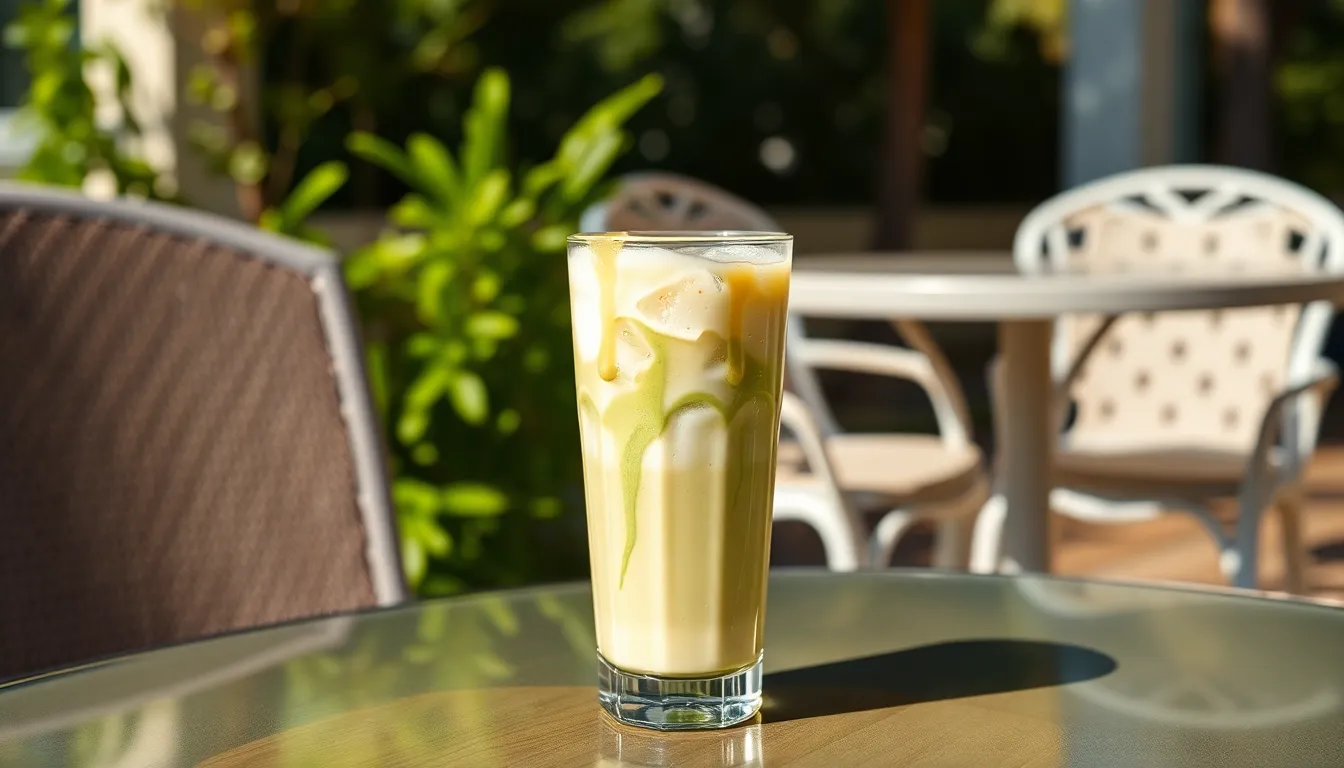
We can easily adapt our vanilla matcha latte recipe to suit different preferences and dietary needs. These variations allow us to enjoy this delicious beverage year-round while accommodating various lifestyle choices.
Iced Vanilla Matcha Latte
We transform our warm vanilla matcha latte into a refreshing cold beverage perfect for warmer weather. Start by preparing the matcha paste using the same whisking technique, then let it cool to room temperature. Fill a tall glass with ice cubes and pour the cooled matcha mixture over the ice. Add cold milk of choice and stir gently to combine. We can customize the sweetness by drizzling honey or pure maple syrup to taste. The result is a vibrant green drink that delivers the same energy boost with a cooling effect that makes it ideal for summer afternoons.
Sugar-Free Options
We can create a naturally sweetened version of our vanilla matcha latte without compromising on flavor. Replace traditional granulated sugar in the vanilla syrup with natural sweeteners like stevia or monk fruit, which provide sweetness without the added calories. These alternatives blend seamlessly into both hot and cold preparations. We recommend starting with smaller amounts of these concentrated sweeteners and adjusting to taste, as they tend to be much sweeter than regular sugar. The earthy matcha flavor pairs beautifully with these natural sweeteners, creating a guilt-free indulgence.
Different Milk Alternatives
We can accommodate various dietary preferences by using non-dairy milk alternatives that create equally delicious results. Oat milk provides exceptional creaminess and froths beautifully, making it our top choice for plant-based versions. Almond milk offers a lighter texture with a subtle nutty flavor that complements the matcha. Coconut milk creates an incredibly rich and tropical twist on our classic recipe. Each alternative brings its own unique characteristics to the drink, and we find that all of them work well with our frothing techniques to achieve that coveted creamy texture.
Storage and Make-Ahead Instructions
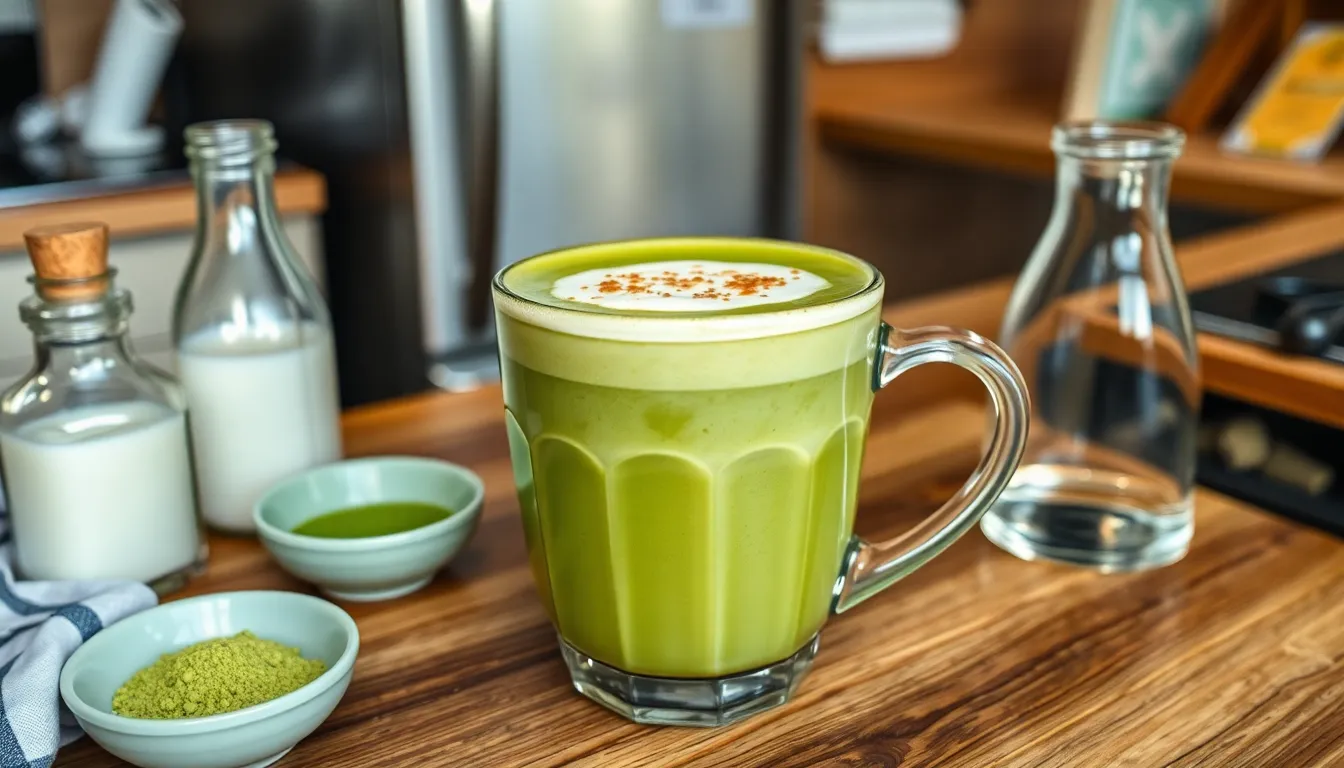
We understand that life gets busy and having your vanilla matcha latte ready when you need it makes all the difference. Proper storage techniques ensure our carefully crafted drink maintains its vibrant flavor and nutritional benefits for optimal enjoyment.
Ingredient Storage Best Practices
Matcha Powder Preservation
We recommend storing matcha powder in an airtight, dark-colored container in the fridge or freezer to preserve freshness, vibrancy, and nutrient content. Return the container immediately after use to avoid condensation and exposure to air that can diminish quality.
Supporting Ingredients
Keep milk and dairy alternatives refrigerated according to manufacturer instructions. Store vanilla extract and flavoring in a cool, dark place such as a pantry or cabinet away from heat and humidity.
Make-Ahead Preparation Options
Unsweetened Matcha Paste
We can prepare matcha paste by whisking matcha with hot water and store it in the refrigerator in an airtight container for up to 24 hours. Add milk and vanilla when ready to serve for the freshest taste experience.
Complete Prepared Latte
Combine all ingredients including matcha, sweetener, milk, and vanilla then store in the refrigerator for up to 24 hours. Stir or shake well before drinking as texture may become less frothy over time.
Storage Limitations
Freezing prepared lattes is not recommended as it can alter texture and separation may occur upon thawing.
Commercial Product Storage
Canned Vanilla Matcha Lattes
Pre-made canned vanilla matcha lattes such as PerfectTed are shelf-stable but perform best when kept refrigerated for optimal freshness. Consume opened cans within the same day and store in the refrigerator immediately after opening.
Key Storage Recommendations
Make single servings to avoid leftovers and ensure maximum freshness. Prepared lattes should be consumed within 24 hours for best quality and flavor retention. Keep all ingredients away from heat, light, and humidity to maintain their beneficial properties.
| Storage Stage | Location | Duration |
|---|---|---|
| Matcha powder | Fridge/Freezer | Long-term |
| Prepared latte | Fridge | Up to 24 hours |
| Canned product | Room temp/fridge | See package |
Conclusion
The vanilla matcha latte represents more than just another trendy beverage – it’s a perfect harmony of tradition and innovation that delivers both comfort and energy. We’ve shown you how this antioxidant-rich drink can easily become part of your daily routine with the right techniques and quality ingredients.
Whether you prefer it hot or iced sugar-free or naturally sweetened this versatile latte adapts to your lifestyle and dietary needs. The ceremonial grade matcha provides sustained energy without the crash while vanilla adds that familiar warmth we all crave.
With proper storage techniques and make-ahead options you can enjoy this café-quality drink whenever the mood strikes. We’re confident that once you master these simple steps you’ll find yourself reaching for this energizing alternative more often than your regular coffee order.
Frequently Asked Questions
What is a vanilla matcha latte?
A vanilla matcha latte is a unique beverage that combines the earthy flavor of matcha green tea with sweet vanilla and creamy milk. This East-meets-West fusion drink offers a smooth, energizing alternative to coffee with a beautiful green color and balanced flavor profile that appeals to both matcha enthusiasts and newcomers.
What are the main ingredients needed for a vanilla matcha latte?
The essential ingredients include ceremonial grade matcha powder, hot water, milk (dairy or plant-based), granulated sugar, pure vanilla extract, and water for making vanilla syrup. Optional ingredients include coconut oil, vanilla bean pod, whipped cream, honey, or maple syrup for customization and enhanced flavor.
What equipment do I need to make a vanilla matcha latte at home?
You’ll need water heating tools (kettle or thermometer), whisking implements (bamboo whisk or electric frother), and milk preparation tools (milk frother or steamer). These tools help achieve barista-quality results by ensuring proper water temperature, smooth matcha paste, and perfectly frothed milk for the ideal texture.
What’s the ideal water temperature for preparing matcha?
The optimal water temperature for matcha is 175°F (79°C). This temperature prevents the matcha from becoming bitter while allowing it to dissolve properly and maintain its vibrant green color. Water that’s too hot can make the matcha taste harsh and unpleasant.
Can I make a sugar-free version of vanilla matcha latte?
Yes, you can easily make a sugar-free vanilla matcha latte by substituting traditional sugar with natural sweeteners like stevia, monk fruit, or sugar-free vanilla syrup. These alternatives maintain the sweet vanilla flavor while accommodating dietary restrictions and preferences without compromising taste.
What milk alternatives work best for vanilla matcha lattes?
Oat milk, almond milk, and coconut milk are excellent alternatives to dairy milk. Oat milk provides the creamiest texture closest to dairy, while almond milk offers a lighter option. Coconut milk adds tropical richness. Each alternative maintains the drink’s delicious flavor while accommodating various dietary needs.
How should I store matcha powder and prepared lattes?
Store matcha powder in an airtight container in the refrigerator to preserve its vibrant color and antioxidant properties. Prepared vanilla matcha lattes should be consumed within 24 hours and stored refrigerated. Avoid freezing as it can alter the texture and separate the ingredients.
Can I make vanilla matcha latte ahead of time?
You can prepare components in advance, such as vanilla syrup (lasts up to one week refrigerated) and matcha paste (best used within a few hours). Complete lattes can be made ahead but should be consumed within 24 hours for optimal freshness and flavor quality.
How do I make an iced vanilla matcha latte?
To make an iced version, prepare the same matcha paste and vanilla syrup as the hot version. Add the mixture to a glass filled with ice cubes, then pour cold milk over the ice. Stir gently and garnish as desired for a refreshing summer variation.
What are the health benefits of vanilla matcha lattes?
Vanilla matcha lattes are rich in antioxidants from the matcha powder and contain L-theanine, an amino acid that promotes calm, focused energy without the jitters often associated with coffee. This makes it an excellent alternative for sustained energy and mental clarity throughout the day.

